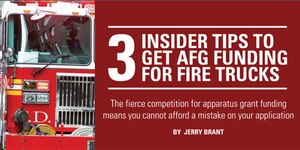
The fierce competition for apparatus grant funding means you cannot afford a mistake on your application
This feature is part of our new Fire Chief Digital Edition, a quarterly supplement to FireChief.com that brings a sharpened focus to some of the most challenging topics facing fire chiefs and fire service leaders everywhere. To read all of the articles included in the Summer 2016 issue, click here.
By Jerry Bryant
While the AFG program receives more than $2 billion in vehicle requests each year, only 25 percent of the available funds can be awarded for vehicles — less than 10 percent of the vehicle requests received.
I’m giving you this information not to scare you away from the program, but to inform you about the level of competition your application faces when it is submitted.
As a grant reviewer for other types of federal programs, I can tell you firsthand that it’s very apparent which applicants have spent the time to collect the information that is essential for a competitive application by presenting it in a clear and concise manner.
If your grant planning committee recommends applying for a new piece of apparatus this year, there are several factors you need to consider if your application is going to compete for AFG funding.
The first of these may seem like a minor point, but to some it can be the item which causes your application to sink as it navigates the AFG review process. That item is: What class of apparatus are you applying for?
As I said, this may sound easy to some. However, you would not believe the phone calls I receive where departments tell me that they want to apply for a new tanker (tender), when in fact what they end up describing to me is not a tanker but an engine with a large water tank.
Remember, AFG has specific designations for apparatus types. You need to read them and be familiar with them before you decide what category of apparatus you are applying for. To do this, you need to know the vehicle’s pump size (gpm) and water tank size.
Just as you need to know this information for the new piece of apparatus, you also need to know the classification of the vehicle you are trying to replace. You may be surprised to find out that the vehicle standing in your second apparatus bay is not really an engine after all.
These items are important, because in your application you will be asked for the age of the newest and oldest vehicle you have in the same class for which you are requesting funds.
Another critical factor to examine for your vehicle application is the AFG vehicle priority matrix. Departments consistently seem to ignore this section and apply for vehicles that have a low priority for their geographic category. Then, they wonder why their application was turned down.
In recent years, FEMA has made this process so much easier than in the past. Simply go to the AFG guidance document and determine if your department is rural, urban or suburban. Next, look at the listing of vehicles in the matrix under your geographic category.
The vehicles will be grouped as either high, medium or low priority. If the vehicle you wish to apply for is listed as a low priority, I can guarantee that your application will not be funded. If your request is for apparatus listed under the medium priority, there is also a good chance that your application will not be funded.
In the past, when AFG was funded at nearly double its current amount, a medium-priority vehicle was a possibility. Today, with a significantly reduced program budget, it is very odd for AFG to fund a request outside the high-priority category.
Jerry Brant is a senior grant consultant and grant writer with FireGrantsHelp and EMSGrantsHelp . He has 46 years of experience as a volunteer firefighter in rural west-central Pennsylvania.
Copyright © 2025 FireGrantsHelp.com. All rights reserved.
